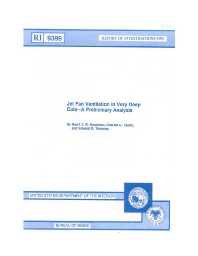Mining Publication: Jet Fan Ventilation in Very Deep Cuts - A Preliminary Analysis
Original creation date: January 1992
Future coal mining systems will be able to cut from crosscut to crosscut where advances could exceed 100 ft. However, limitations arise when ventilating such mining systems. In deep advance mining, there would be no workers at the face to advance ventilation tubing or curtain manually. Traditional methods also provide no means for maintaining face ventilation after the miner backs away from the face. U.S. Bureau of Mines research is studying means to provide effective ventilation at cut depths beyond the current limit of 40 ft. Several innovative ventilation schemes are currently being considered. One such method is the use of a jet fan to ventilate a deep cut. A jet fan is simply a freestanding fan using little or no ducting to direct the ventilation flow. Jet fan testing in a 90-ft entry revealed that higher exit velocities and greater penetration depth occurred when various configurations were used to confine and direct the air flow. Additional testing also indicated that 2,200 cfm of fresh air was delivered to the face 90 ft distant when a check curtain was used to limit entrainment around the fan. Without this curtain, this quantity dropped to only 1,000 cfm. This testing indicated that a jet fan was capable of providing ventilation to a distant face area. It also highlighted potential problems, such as recirculation at the fan and reentrainment in the jet flow. Despite these potential problems, jet fans may be adequate for ventilating cuts exceeding 40 ft.
Authors: GV Goodman, CD Taylor, ED Thimons
Report of Investigations - January 1992
NIOSHTIC2 Number: 10011118
Pittsburgh, PA: U.S. Department of the Interior, Bureau of Mines, RI 9399, 1992 Jan; :1-12
See Also
- Bolt Load Changes During Initial Face Advance and Cross-Cut Breakthrough
- Effects of Water Sprays Used With a Machine-Mounted Scrubber on Face Methane Concentrations
- Evaluation of Face Dust Concentrations at Mines Using Deep-Cutting Practices
- Guidelines for the Control and Monitoring of Methane Gas on Continuous Mining Operations
- Lowering Respirable Dust at an Iron Ore Concentrator Plant Through Improved Ventilation Practices
- Measurement of Airflow in a Simulated Underground Mine Environment Using an Ultrasonic Anemometer
- Prediction of Longwall Methane Emissions and the Associated Consequences of Increasing Longwall Face Lengths: A Case Study in the Pittsburgh Coalbed
- Simulation of Methane Flows in Noncoal Mines
- Technology News 439 - Remote Reset Systems for Continuous Mining Machines Used In Extended Cuts
- Technology News 465 - Method for Predicting Methane Emissions on Extended Longwall Faces
- Content source: National Institute for Occupational Safety and Health, Mining Program


 ShareCompartir
ShareCompartir
